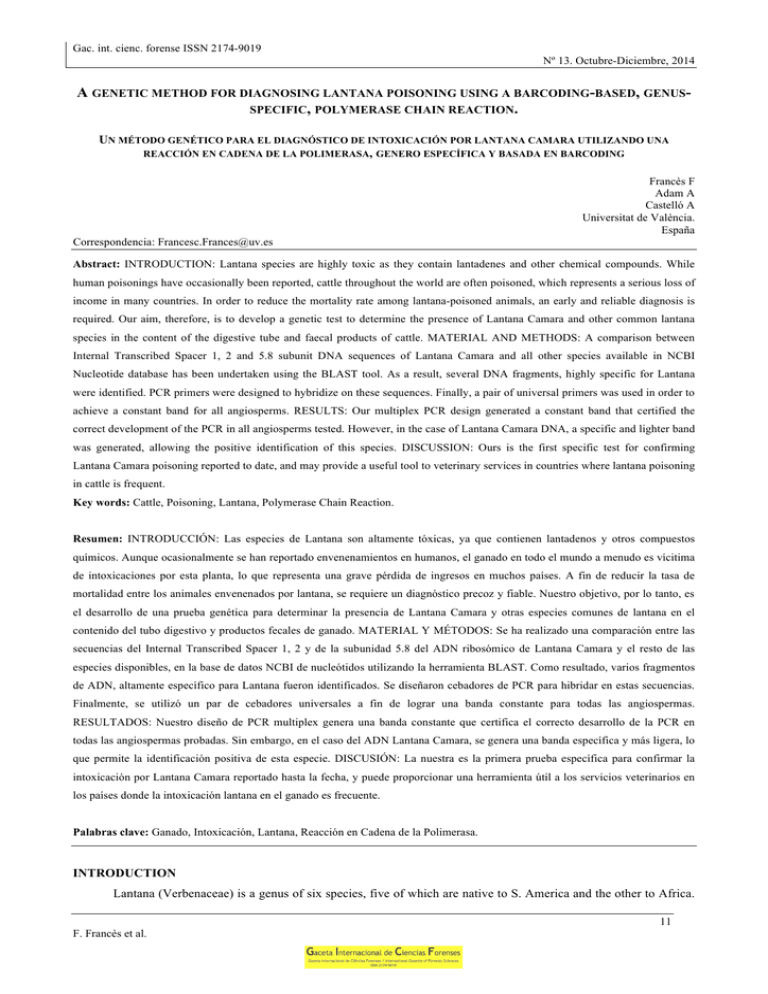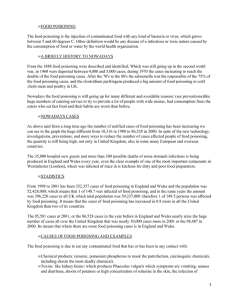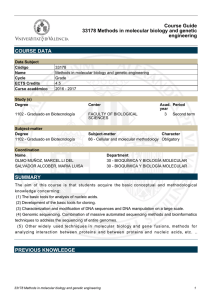a genetic method for diagnosing lantana poisoning using a
Anuncio

Gac. int. cienc. forense ISSN 2174-9019 Nº 13. Octubre-Diciembre, 2014 A GENETIC METHOD FOR DIAGNOSING LANTANA POISONING USING A BARCODING-BASED, GENUSSPECIFIC, POLYMERASE CHAIN REACTION. UN MÉTODO GENÉTICO PARA EL DIAGNÓSTICO DE INTOXICACIÓN POR LANTANA CAMARA UTILIZANDO UNA REACCIÓN EN CADENA DE LA POLIMERASA, GENERO ESPECÍFICA Y BASADA EN BARCODING Francès F Adam A Castelló A Universitat de València. España Correspondencia: [email protected] Abstract: INTRODUCTION: Lantana species are highly toxic as they contain lantadenes and other chemical compounds. While human poisonings have occasionally been reported, cattle throughout the world are often poisoned, which represents a serious loss of income in many countries. In order to reduce the mortality rate among lantana-poisoned animals, an early and reliable diagnosis is required. Our aim, therefore, is to develop a genetic test to determine the presence of Lantana Camara and other common lantana species in the content of the digestive tube and faecal products of cattle. MATERIAL AND METHODS: A comparison between Internal Transcribed Spacer 1, 2 and 5.8 subunit DNA sequences of Lantana Camara and all other species available in NCBI Nucleotide database has been undertaken using the BLAST tool. As a result, several DNA fragments, highly specific for Lantana were identified. PCR primers were designed to hybridize on these sequences. Finally, a pair of universal primers was used in order to achieve a constant band for all angiosperms. RESULTS: Our multiplex PCR design generated a constant band that certified the correct development of the PCR in all angiosperms tested. However, in the case of Lantana Camara DNA, a specific and lighter band was generated, allowing the positive identification of this species. DISCUSSION: Ours is the first specific test for confirming Lantana Camara poisoning reported to date, and may provide a useful tool to veterinary services in countries where lantana poisoning in cattle is frequent. Key words: Cattle, Poisoning, Lantana, Polymerase Chain Reaction. Resumen: INTRODUCCIÓN: Las especies de Lantana son altamente tóxicas, ya que contienen lantadenos y otros compuestos químicos. Aunque ocasionalmente se han reportado envenenamientos en humanos, el ganado en todo el mundo a menudo es vícitima de intoxicaciones por esta planta, lo que representa una grave pérdida de ingresos en muchos países. A fin de reducir la tasa de mortalidad entre los animales envenenados por lantana, se requiere un diagnóstico precoz y fiable. Nuestro objetivo, por lo tanto, es el desarrollo de una prueba genética para determinar la presencia de Lantana Camara y otras especies comunes de lantana en el contenido del tubo digestivo y productos fecales de ganado. MATERIAL Y MÉTODOS: Se ha realizado una comparación entre las secuencias del Internal Transcribed Spacer 1, 2 y de la subunidad 5.8 del ADN ribosómico de Lantana Camara y el resto de las especies disponibles, en la base de datos NCBI de nucleótidos utilizando la herramienta BLAST. Como resultado, varios fragmentos de ADN, altamente específico para Lantana fueron identificados. Se diseñaron cebadores de PCR para hibridar en estas secuencias. Finalmente, se utilizó un par de cebadores universales a fin de lograr una banda constante para todas las angiospermas. RESULTADOS: Nuestro diseño de PCR multiplex genera una banda constante que certifica el correcto desarrollo de la PCR en todas las angiospermas probadas. Sin embargo, en el caso del ADN Lantana Camara, se genera una banda específica y más ligera, lo que permite la identificación positiva de esta especie. DISCUSIÓN: La nuestra es la primera prueba específica para confirmar la intoxicación por Lantana Camara reportado hasta la fecha, y puede proporcionar una herramienta útil a los servicios veterinarios en los países donde la intoxicación lantana en el ganado es frecuente. Palabras clave: Ganado, Intoxicación, Lantana, Reacción en Cadena de la Polimerasa. INTRODUCTION Lantana (Verbenaceae) is a genus of six species, five of which are native to S. America and the other to Africa. 11 F. Francès et al. Gac. int. cienc. forense ISSN 2174-9019 Nº 13. Octubre-Diciembre, 2014 Lantana Camara, apart from its decorative use, is also used as a soil-enriching agent (1). Lantana Camara is widely distributed throughout the world, being an invasive species in wild ecosystems and pastures in countries such as India and Australia. This plant, however, is highly toxic. Several cases of fatal human poisoning have been reported in the U.S. and India (2, 3). Lantana has also been implicated in the poisoning of cattle, buffalo, goats (4), horses and dogs (2), captive red kangaroos (5), ostriches (6), goats (7) cows and sheep (8). Cattle poisoning has a severe economic impact in regions where cattle raising represents an important source of income. Both fresh and dehydrated leaves, as well as berries are toxic by ingestion, mainly due to their A, B and D lantadene content, together with compound 9 and icterogenic acid (9). After absorption, lantadenes are carried to the liver through the portal vein. They are metabolised by the liver and excreted to bile, where they injure bile canalicular membranes, thus inhibiting bile secretion. This cholestasis generates hyperbilirrubinemia, photosensibilisation and ruminal stasis, the latter causing progressive liver damage (10). The diagnosis of lantana poisoning is based on clinical findings, blood biochemistry tests and is usually confirmed by visual demonstration of lantana leaves and fruit in faecal content and the identification of lantana plants in the pasture. If poisoning has caused the death of the animal, additional autopsy data on the findings in organs such as the liver, kidney and others could strengthen the diagnosis, and detailed observation of the digestive tube content may confirm the presence of the plant. In non-fatal cases, an early and accurate diagnosis is necessary to undertaken an appropriate treatment, based on avoiding solar light, hepatoprotection, and antibiotic profilaxis of cutaneous lesions. Other treatment options, such as lantadene A/B vaccination (11) activated charcoal (12) and oral bentonite (13) have been proposed. As stated above, quick diagnosis improves the possibility of a good response to treatment. Thus, our aim is to develop a specific diagnostic test for detecting lantana DNA in poisoned cattle using a barcoding PCR-based technique. MATERIAL AND METHODS DNA extraction. DNA was isolated from lantana leaves and berries by the following method: 20 mg of plant material was macerated with 400 µL of extraction buffer ( 100 mM Tris-HCl, 100 mM EDTA, 250 mM NaCl), together with 10 µL of Dithiotreithol, 10 µL of 10 µg/µL proteinase K, 8 µL of 98% 2-Mercaptoethanol and 10 µL of 20% SDS. In the case of berries and seeds, these were reduced to powder prior to the addition of the extraction buffer. After gently mixing, samples were incubated for one hour at 65ºC. 400 µL of phenol-chloroform were then added to each tube, and following brief agitation, we proceeded to centrifuge tubes for 5 minutes at 15000 rpm. The resulting aqueous phase was transferred to a new tube, and after adding one volume of isopropanol, samples were incubated for 2 hours at -20ºC and centrifugued at 15000 rpm for 10 minutes. The resulting pellet was washed with one volume of 70% ethanol and samples were again centrifuged at 15000 rpm for 5 minutes. Finally, and after the evaporation of ethanol residues, the pellet was finally re-suspended with 100 µL of bidistilled water. Apart from Lantana Camara, isolation of several other angiosperm species (Pittosporum tobira, together with grass species Cynodon Dactylon, Festuca Arundinacea and Zoysia Japonica) were undertaken in order to validate the in vitro specificity of the test. PCR design In order to specifically detect lantana DNA, we proceeded to search the NCBI Nucleotide database for lantana sequences corresponding to the 5.8 Subunit ribosomal DNA, together with the internal transcribed spacers 1 and 2 (GenBank accession: AF437863.1). A comparison with other reported sequences using the NCBI BLAST tool was then 12 F. Francès et al. Gac. int. cienc. forense ISSN 2174-9019 Nº 13. Octubre-Diciembre, 2014 undertaken, and we proceeded to identify lantana-specific sequences. Once these limited sequences were identified, PCR primers were designed in order to hybridize on these lantana-specific DNA regions, using the primer 3 software (14). Resulting primers (forward- GCGTAAGCAACCGACGAG and reverse- GCCAACCGCGCACTTATC ) were complementary to ITS1-5.8S ribosomal subunit -ITS2 sequences of Lantana Camara, Lantana Depressa and Lantana Horrida. Furthermore, in order to test the success of the PCR in the event of an absence of Lantana DNA, a pair of universal primers (ITS1 and ITS4) were selected (15). This PCR design would generate a constant 589 bp and, in the event of lantana DNA existing in the sample, a 392 bp specific fragment would be produced. PCR parameters PCR conditions and reagents were as follows: DNA was amplified in a 96-plate thermocycler (Eppendorf, Hamburg). The reaction mixture used in the PCR consisted of 10 ng of genomic DNA, 0.2µM of each primer, 0.6 U of Go Taq Polymerase (Promega,Madison USA), 2.5 mM of MgCl2, 10mM of Tris-HCl (10x) and 200µM each deoxynocleotide triphosphate (dNTPs) (Roche Diagnostics GMBH, Germany), in a total volume of 25 µl . After an initial denaturation at 94ºC for 6 minutes, 30 PCR cycles were performed with 45 s of denaturation at 94ºC, 45 s of annealing at 58°C, and an extension for 45 s at 72°C. Finally, a single extension step at 72°C for 10 min was performed. Amplified products were separated by horizontal electrophoresis in a 2% agarose gel. After 10 min exposure to ethidium bromide, DNA fragments were visualized using ultraviolet light. RESULTS DNA isolation protocol was successfully applied to fresh leaves, as well as to Lantana Camara berries and seeds. DNA was also isolated from the fresh leaves of the other non-related species tested. For the in vitro validation, after performing a PCR on DNA from lantana and five other random species that were being studied for other purposes, we could observe that, in the case of PCRs performed on non-lantana DNAs, only the constant universal band was produced, but when lantana DNA was present, this band was substituted by the expected 392 bp band, specific for lantana species. None of the tested non-lantana DNAs gave positive amplifications in the lantana-specific molecular weight range. The disappearance of the universal band in the case of lantana amplification was probably due to reagent competition phenomena. Given that this outcome did not alter the interpretation of the test, no further modifications were considered. Figure 1 shows the test results in different plant species, including Lantana Camara. Figure 1 DISCUSSION Lantana poisoning is commonly reported in cattle, and an early and reliable diagnosis is crucial for achieving 13 F. Francès et al. Gac. int. cienc. forense ISSN 2174-9019 Nº 13. Octubre-Diciembre, 2014 the best therapeutic response. Thus, to be able to unequivocally show the presence of lantana in vomit, digestive tube or faecal material would be very useful for this purpose. No specific diagnostic test has been proposed to date. Barcoding analysis has recently been proposed in investigating the phylogenetic relationships between plant species (16) and for identifying plants in gastric content in forensic cases (17). Thus, we have undertaken a wide sequence comparison using the NCBI digital databases, and through the identification of lantana specific sequences in the internal transcribed spacer 1 and 2, together with the 5.8 ribosomal subunit, we have developed lantana-specific primers that theoretically will only generate an amplicon when DNA from Lantana Camara, Lantana Horrida and Lantana Depressa is present in the sample. The proposed test gave clear and unequivocal results, and outcomes were successfully validated in vitro by undertaking the test on DNAs from other unrelated angiosperms. The visual identification of lantana in vomit or faeces can be difficult. When studying faecal content, leaves are usually unidentifiable, but lantana fruit and seeds can be observed (18). Therefore, following a morphologic suspect diagnosis, our confirmatory method, undertaken on semi-digested leaves or faecal seeds, would establish a reliable diagnosis of lantana poisoning in less than six hours. Plant DNA isolation and following PCR may potentially fail in species and samples with important amounts of polyphenols and polysaccharides. Problems due to the polyphenols may be fixed by using 2-mercaptoethanol and dithiotreitol. On the other hand, the avoidance of polysaccharides in the resulting pellet can be achieved by adding CTAB (Cetyltrimethylammonium Bromide). In our in vitro tests, Lantana Camara DNA isolation has been successfully performed without adding CTAB. However, in an in vivo context, we highly recommend the use of 2% CTAB because samples obtained from the animal will probably consist of a mix of several plant species, and the high polysaccharide concentration risk will be probably high. In addition, the possibility remains of false positives due to unspecific amplifications. However, this risk seems very low as the eventual unspecific amplicon would have to share the same molecular weight as the lantana-specific band in order to cause real confusion in the interpretation of the outcome, and this would seem to be highly improbable. In conclusion, we believe that this easy-to-use test provides a fast, cheap and genus-specific method for diagnosing lantana poisoning. Veterinarian services of countries where lantana plant invasion (mainly L. Camara) of pastures is frequent, such as Australia, New Zealand, India or American countries, could make use of this test in order to achieve an early and reliable diagnosis of this type of poisoning. BIBLIOGRAPHY 1.- Munir AA. A taxonomic review of Lantana camara L. and L. montevidensis (Spreng.) Briq. (Verbenaceae) in Australia. Journal of the Adelaide Botanic Gardens 1996; 17: 1-27. 2.- Morton JF. Lantana, or Red Sage (Lantana camara L., [Verbenaceae]), Notorious Weed and Popular Garden Flower; Some Cases of Poisoning in Florida. Economic Botany 1994;3:259-270. 3.- Sharma OP: Plant toxicosis in north–western India. In: Plantassociated Toxins: Agricultural, Phytochemical and Ecological Aspects. CAB International. Wallingford, UK, 1994, pp. 19-24. 4.- Sharma OP, Makkar HP, Dawra RK. A review of the noxious plant Lantana camara. Toxicon 1988;26:975-987. 5.- Johnson JH, Jensen JM. Hepatotoxicity and secondary photosensitization in a red kangaroo (Megaleia rufus) due to ingestion of Lantana camara. Journal of Zoo and Wildlife Medicine 1998;29:203-207. 6.- Cooper RG. Poisoning in ostriches following ingestion of toxic plants--field observations. Tropical Animal Health and Production 2007;39:439-442. 7.-Ide A, Tutt CL. Acute Lantana camara poisoning in a Boer goat kid. Journal of the South African Veterinary Association 1998;69:30-2. 14 F. Francès et al. Gac. int. cienc. forense ISSN 2174-9019 Nº 13. Octubre-Diciembre, 2014 8.-De Farias Brito, M, Tokarnia CH, Dobereiner J. A toxidez de diversas Lantanas para bovinos e ovinos no Brasil. Pesquisa Veterinária Brasilera 2004;24:3 9.- Ngassoum M.B, Yonkeu S Jirovetz L, Buchbauer G, Schmaus G, Hammerschmidt FJ. Chemical composition of essential oils of Lantana camara leaves and flowers from Cameroon and Madagascar. Flavour and Fragance Journal 1999;14:245-250. 10.- Pass MA. Current ideas on the pathophysiology and treatment of lantana poisoning of ruminants. Australian Veterinary Journal 1986;63:169-171. 11.- Stewart C, Lamberton JA, Fairclough RJ, Pass MA. Vaccination as a possible means of preventing lantana poisoning. Australian Veterinary Journal 1988;65:349-352. 12.- Pass MA, Stewart C. Administration of activated charcoal for the treatment of lantana poisoning of sheep and cattle. J of Applied Toxicology 1984;4:267-269. 13.- McKenzie RA. Bentonite as therapy for Lantana camara poisoning of cattle. Australian Veterinary Journal 1991;68:146-148. 14.- Rozen S, Skaletsky HJ. Primer3 on the WWW for general users and for biologist programmers. In: Bioinformatics Methods and Protocols: Methods in Molecular Biology. Humana Press. Totowa, 2000, pp. 365-386. 15.- White TJ, Bruns T, Lee S, Taylor JW. Amplification and direct sequencing of fungal ribosomal RNA genes for phylogenetics. In: PCR Protocols: A Guide to Methods and Applications, eds. Academic Press Inc. New York, 1999, pp. 315-322. 16.- Sass C, Little DP, Stevenson DW, Specht CD. DNA barcoding in the cycadales: testing the potential of proposed barcoding markers for species identification of cycads. PLoS One 2007;2:e1154. 17.- Lee EJ, Kim SC, Hwang IK, Yang HJ, Kim YS, Han MS, Yang MS, Lee YH. The identification of ingested dandelion juice in gastric contents of a deceased person by direct sequencing and GC-MS methods. Jouornal of Forensic Science 2009;54:7217. 18.- Montero-Urdaneta, M., Fernández R, Negrón G, Isea G, Gutiérrez JC. Intoxicación por Lantana camara (Cariaquito colorado) en un bovino lactante. RETEL. http://www.sertox.com.ar/retel/n12/001.pdf (accessed September 2014) 15 F. Francès et al.


